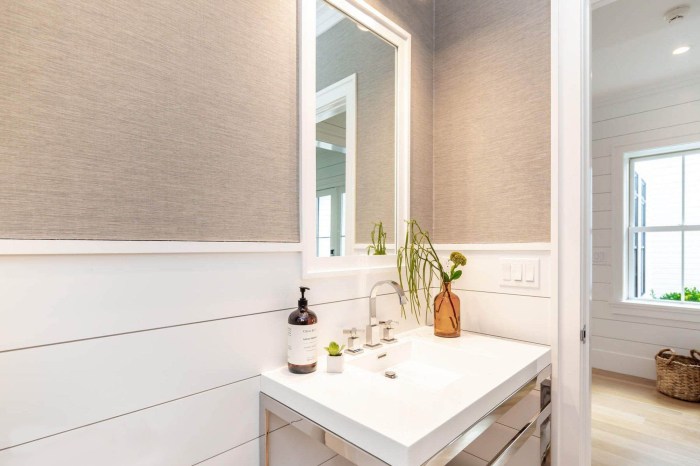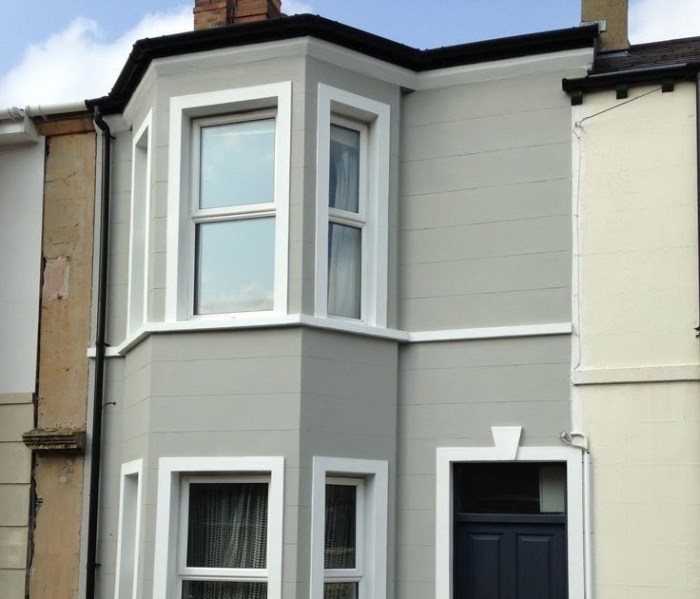Transform your bathroom into an oasis of style and functionality with bathroom panelling ideas. From modern to traditional, rustic to luxurious, there’s a world of possibilities to explore. Dive in and discover the materials, designs, and techniques that will turn your bathroom into a masterpiece.
Explore the pros and cons of different materials, such as PVC, fiberglass, and ceramic tile, to find the perfect match for your needs. Unleash your creativity with various design styles, from sleek and contemporary to timeless and elegant. Discover how paneling patterns, colors, and finishes can impact the visual appeal and space perception.
Bathroom Paneling Materials
Bathroom paneling is an excellent way to upgrade your bathroom’s aesthetics and functionality. Choosing the right material is crucial to ensure durability, moisture resistance, and overall satisfaction.
Common bathroom paneling materials include:
PVC Panels
- Advantages: Waterproof, lightweight, easy to install, budget-friendly.
- Disadvantages: Can be prone to scratches, may fade over time.
Fiberglass Panels
- Advantages: Durable, non-porous, mold-resistant, easy to clean.
- Disadvantages: Can be more expensive than other materials, may not be as aesthetically versatile.
Ceramic Tile
- Advantages: Highly durable, waterproof, customizable, classic aesthetic.
- Disadvantages: Can be more expensive and labor-intensive to install, grout lines may require regular maintenance.
Design Styles
Bathroom paneling offers a vast array of design styles, allowing you to tailor your bathroom to your unique aesthetic. From sleek and modern to cozy and rustic, the possibilities are endless.
To create a cohesive and stylish look, consider the overall design of your bathroom. If you have a modern bathroom with clean lines and minimalist fixtures, opt for paneling with a similar aesthetic. For a traditional bathroom, choose paneling with classic details like beadboard or wainscoting.
And for a rustic bathroom, consider wood paneling with a distressed finish.
Modern Styles
- Sleek and minimalist designs
- Neutral colors and clean lines
- Geometric patterns and metallic accents
Traditional Styles, Bathroom panelling ideas
- Classic details like beadboard or wainscoting
- Rich colors and intricate patterns
- Ornate moldings and hardware
Rustic Styles
- Natural materials like wood and stone
- Distressed finishes and reclaimed wood
- Earthy colors and simple designs
Paneling Patterns
Paneling patterns play a significant role in shaping the visual appeal and space perception of a bathroom. Different patterns create distinct effects, influencing the overall ambiance and functionality of the room.
Horizontal Paneling
Horizontal paneling creates a sense of width and makes the bathroom appear more spacious. It is particularly suitable for small bathrooms or those with low ceilings. Horizontal lines draw the eye across the room, making it feel wider.
Vertical Paneling
Vertical paneling, on the other hand, adds height to the bathroom. It is an excellent choice for bathrooms with high ceilings or narrow spaces. Vertical lines draw the eye upwards, making the room feel taller and more open.
Diagonal Paneling
Diagonal paneling is a unique and dynamic pattern that adds visual interest to the bathroom. It can create a sense of movement and depth, making the room feel more spacious and dynamic. Diagonal lines can also help to hide imperfections in the walls or ceiling.
Colors and Finishes
Bathroom paneling comes in a vast array of colors and finishes, allowing homeowners to customize their bathrooms to match their personal style and the overall design of their homes.
When selecting colors and finishes, it is important to consider the size, shape, and lighting of the bathroom. Lighter colors can make a small bathroom feel larger, while darker colors can create a more intimate atmosphere. Glossy finishes reflect light, making the bathroom feel brighter, while matte finishes absorb light, creating a more subdued look.
Neutral Colors
Neutral colors, such as white, gray, and beige, are popular choices for bathroom paneling because they go with any color scheme. They can be paired with bright accents to create a more lively look, or they can be kept simple for a more minimalist aesthetic.
Bold Colors
Bold colors, such as red, blue, and green, can add a touch of drama to a bathroom. They can be used to create a focal point or to simply add a splash of color. When using bold colors, it is important to choose a finish that will complement the color and the overall design of the bathroom.
Finishes
Bathroom paneling is available in a variety of finishes, including glossy, matte, and textured. Glossy finishes are easy to clean and reflect light, making them a good choice for small bathrooms. Matte finishes absorb light, creating a more subdued look.
Textured finishes add visual interest and can help to hide imperfections in the walls.
Decorative Accents
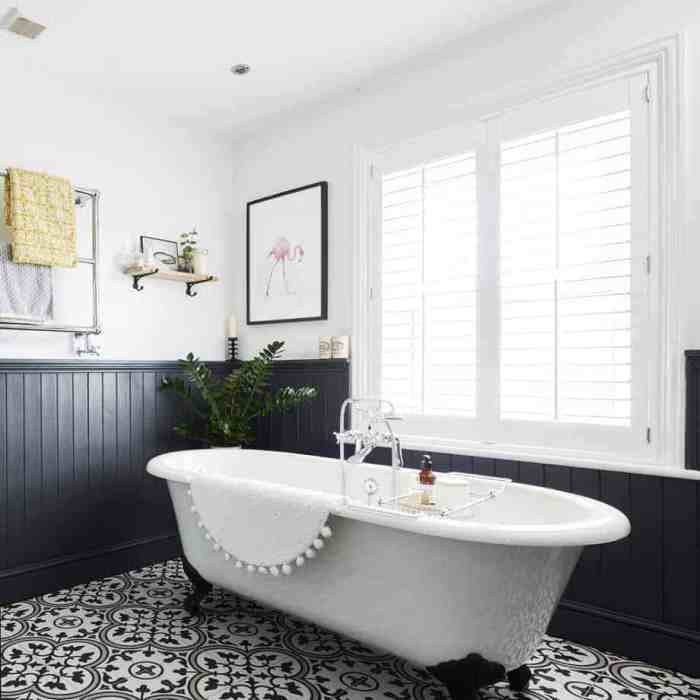
Incorporate decorative accents to elevate the visual appeal of your paneled bathroom.
Tastefully enhance the paneling by adding borders, moldings, or trim. These elements frame and define the panels, creating a more polished and sophisticated look.
Borders
- Add a thin border around the edges of the panels to create a subtle yet elegant accent.
- Choose a border that complements the color and style of the paneling, or opt for a contrasting color for a bolder statement.
Moldings
- Install moldings along the top and bottom edges of the panels to add depth and dimension.
- Select moldings with intricate designs or simple profiles to match the overall style of the bathroom.
Trim
- Use trim to create a finished look around windows, doors, and other openings in the bathroom.
- Choose trim that matches the color and material of the paneling or opt for a contrasting material for a unique touch.
Lighting Considerations
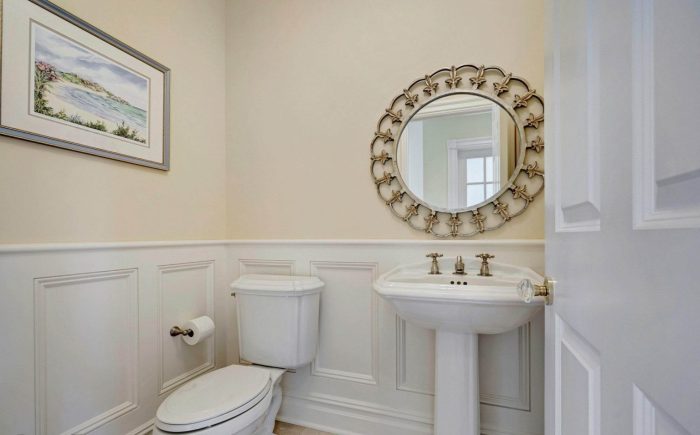
Lighting plays a crucial role in enhancing the aesthetics and functionality of bathroom paneling. The right lighting fixtures and placement can highlight textures, create depth, and set the overall ambiance of the space.
Consider the following tips when choosing lighting for your bathroom paneling:
Fixture Selection
- Recessed Lighting:Flush-mounted fixtures that provide ambient lighting and minimize shadows.
- Pendant Lights:Hanging fixtures that add a touch of style and provide focused lighting over specific areas.
- Wall Scones:Mounted on walls, they offer both ambient and task lighting, perfect for mirrors and vanity areas.
- Under-Cabinet Lighting:Concealed fixtures that illuminate the countertops and reduce shadows.
Placement
- Ambient Lighting:Place fixtures evenly throughout the bathroom to provide overall illumination.
- Task Lighting:Focus lighting fixtures over specific areas such as the mirror, shower, or bathtub.
- Accent Lighting:Use directional fixtures to highlight textures or create visual interest on the paneling.
- Natural Light:Maximize natural light by installing windows or skylights, as it enhances the appearance of the paneling and creates a brighter, more inviting atmosphere.
Installation Techniques: Bathroom Panelling Ideas

Bathroom paneling installation techniques vary based on the type of paneling material used. Here’s a breakdown of the most common methods:
Glue
Glue is a convenient and straightforward method for installing lightweight paneling, such as PVC or acrylic. It requires minimal tools and provides a strong and durable bond.
- Prepare the wall surface by cleaning and ensuring it’s flat and smooth.
- Apply a thin layer of adhesive to the back of the paneling.
- Align the paneling on the wall and press firmly into place.
- Use spacers or clamps to ensure the panels are level and secure.
- Wipe away any excess adhesive that may squeeze out.
Screws
Screws offer a more secure installation method, especially for heavier paneling materials like wood or metal. It’s a slightly more involved process but provides excellent durability.
- Mark the stud locations on the wall.
- Pre-drill pilot holes into the paneling and studs.
- Insert screws into the pilot holes and tighten them securely.
- Countersink the screws slightly below the surface of the paneling.
- Fill the screw holes with matching caulk or putty for a seamless finish.
Maintenance and Care
Preserving the pristine condition of your bathroom paneling is crucial for both aesthetic appeal and longevity. Regular cleaning and proper care will ensure your paneling retains its beauty and functionality for years to come.
To maintain your bathroom paneling, follow these steps:
Cleaning
- Wipe down the paneling regularly with a damp cloth and mild detergent. Avoid using harsh chemicals or abrasive cleaners, as they can damage the finish.
- For tougher stains, use a soft-bristled brush with a gentle cleaning solution. Avoid scrubbing too vigorously, as this can scratch the surface.
- Rinse the paneling thoroughly with clean water and dry it with a soft cloth to prevent water spots.
Prevention
- Avoid hanging heavy objects on the paneling, as this can cause it to sag or buckle.
- Protect the paneling from direct sunlight, as prolonged exposure can cause fading or discoloration.
- Keep the bathroom well-ventilated to prevent moisture buildup, which can lead to mold or mildew growth.
Trends and Innovations
Bathroom paneling is embracing modern advancements, introducing innovative materials and designs that redefine functionality and aesthetics.
- Eco-friendly materials:Sustainable options like bamboo and recycled plastics minimize environmental impact while adding a touch of nature to your bathroom.
- 3D wall panels:These panels create depth and texture, adding a dramatic touch to bathroom walls. They can mimic natural materials like stone or wood, offering a unique and immersive experience.
- Smart panels:Equipped with sensors and LED lights, smart panels enhance convenience and create personalized lighting scenarios. They can be controlled remotely, offering hands-free functionality.
- Antibacterial and antimicrobial surfaces:Hygiene is paramount in bathrooms. Antibacterial and antimicrobial panels inhibit the growth of bacteria and mold, promoting a cleaner and healthier environment.
Last Word
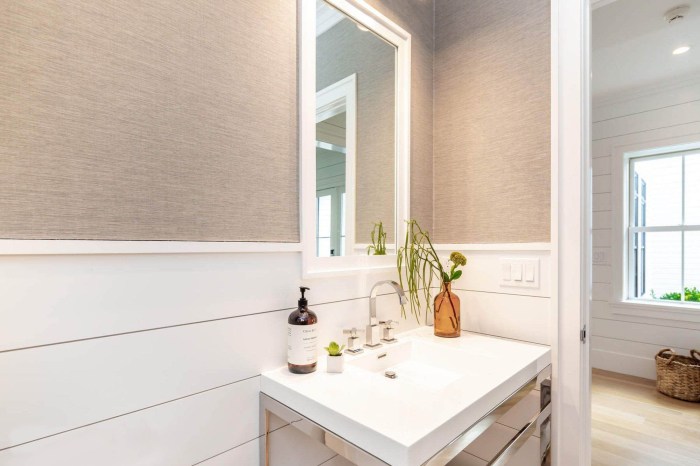
Elevate your bathroom’s aesthetics with decorative accents, such as borders, moldings, and trim. Consider lighting fixtures and placement to enhance the overall ambiance. Embrace emerging trends and innovations that push the boundaries of bathroom design. Whether you’re aiming for a complete remodel or a stylish refresh, bathroom panelling ideas will guide you towards creating a space that’s both beautiful and practical.
Questions and Answers
What are the benefits of bathroom panelling?
Bathroom panelling offers numerous benefits, including increased moisture resistance, durability, ease of maintenance, and enhanced aesthetics.
How do I choose the right bathroom panelling material?
Consider factors such as moisture resistance, durability, style, and cost when selecting the ideal material for your bathroom panelling.
What are some popular bathroom panelling design styles?
Modern, traditional, rustic, and contemporary are some popular design styles for bathroom panelling.
How can I incorporate decorative accents into my bathroom panelling?
Borders, moldings, and trim are excellent decorative accents that can enhance the visual appeal of your bathroom panelling.
